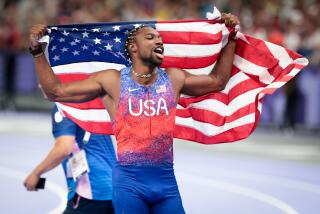Track / Mal Florence : It’s One Small Step, One Great Jump for Banks
- Share via
There was nothing tainted about Willie Banks’ world-record leap of 58 feet 11 1/2 inches Sunday night in the triple jump at The Athletics Congress USA-Mobil outdoor track meet at Indianapolis.
But Banks volunteered that his mark may be viewed with some skepticism in Europe.
“There will be varied reaction, and some people might say I was on drugs,” Banks said. “I’ve never been on drugs in my life. I don’t need it and I’ve never needed it. When the time comes to take drugs to jump far, I’ll quit.”
Banks broke a revered record, the 58-8 1/2 mark set by Brazil’s Joao de Oliveira in the thin air of Mexico City in 1975.
It was important to Banks that he broke the record at sea level. Carl Lewis wants it that way, too, if he breaks Bob Beamon’s world long-jump record of 29-2 1/2, also set at high altitude in Mexico City in 1968.
De Oliveira beat the triple jump record by 17 3/4 inches when he broke it 10 years ago, making Banks’ accomplishment all the more remarkable.
Beamon also made a quantum leap, breaking the previous world record by 21 1/2 inches.
World-record progression usually occurs in modest increments but there have been some notable exceptions.
Jack Torrance broke his own world shotput record by a foot and half with his effort of 57-1 in 1934. Germany’s Rudolf Harbig took almost two seconds off the 800-meter record with his time of 1:46.6 in 1939, and East Germany’s Uwe Hohn broke Tom Petranoff’s javelin record by 16 feet 8 inches with a throw of 343-10 in 1984.
Banks’ next meet will be Saturday at Berkeley in the Footlocker Summer Games, held in conjunction with the Pacific Conference Games involving national teams from the United States, Australia, New Zealand, Japan and Canada.
As the world record-holder, Banks should be in demand on the European circuit.
“I’m going to have so much fun there,” he said. “I’m just going to blow it out. I’ll high-jump, long-jump and triple-jump, but I won’t run anything beyond 200 meters.”
Banks said that he worked out on his own before joining the L.A. Track Club this season. He said he is a garrulous person by nature and has benefited from the companionship of his teammates.
“I’m working harder now, and it’s no longer a job like it was when I was working for the Olympic gold medal (he finished sixth),” he said. “I feel like a kid again at 29.”
The all-time U.S. triple jump list was rearranged after the competition at Indianapolis.
Banks, Mike Conley at 58-1 3/4, Charles Simpkins at 57-5 3/4 and Al Joyner at 57-3 1/2 became the top four American performers in the event.
Lewis, who was hampered by a leg injury, dismissed it as minor after failing to qualify for the 100-meter finals Saturday night at Indianapolis.
Nevertheless, Lewis will be examined here today by Dr. Tony Daly, the chief medical officer of the Summer Olympics.
He reportedly has a strained lower hamstring in his right leg that hasn’t completely responded to treatment since he injured it while long jumping May 18 at the Pepsi Invitational.
Lewis has a busy European schedule starting with a meet in London July 14. But his manager, Joe Douglas, said Tuesday that Lewis may not be able to compete until August.
Don Paige was regarded as one of the most promising young middle distance runners in the world five years ago while competing for Villanova.
His 800-1,500 double in the 1979 NCAA meet was an outstanding achievement, considering that he had only a half-hour’s rest between races. He came back in 1980 to repeat as the 800 titlist in the NCAA meet.
An athlete with a withering kick, Paige was expected to seriously threaten Sebastian Coe’s world record of 1:41.73 in the 800, set in 1981.
But Paige hasn’t been able to live up to that promise. He has had chronic foot injuries in recent years and he is just competing for the fun of it.
He failed to qualify for the U.S. team in the 800 last June in the Olympic trials and was a nonqualifier in the national meet with the pedestrian time of 1:48.27.
“I have arthritis in my toes and I can hardly move them,” Paige said at Indianapolis. “It’s especially difficult when you run on your toes. So that limits my training. But I still like to compete. I still enjoy it.”
A one-day double for the ages: That was the performance by Arkansas’ Conley at the national meet. He had a wind-aided long jump of 28 feet, then came back in the triple jump with a legal leap of 58-1, the second-best mark recorded at sea level.
Conley became the sixth athlete to jump 28 feet or farther under any conditions. Others are Beamon, Lewis, Larry Myricks, East Germany’s Lutz Dombroski and Jason Grimes, who had a wind-assisted mark.
The well never seems to run dry in regard to U.S. sprint prospects.
Roy Martin of Roosevelt High School in Dallas may be the next great American sprinter. Martin, who is headed for SMU, equaled his national high school record of 20.13 in the 200, barely losing to Houston’s Kirk Baptiste (20.11) in the national meet.
More to Read
Go beyond the scoreboard
Get the latest on L.A.'s teams in the daily Sports Report newsletter.
You may occasionally receive promotional content from the Los Angeles Times.










